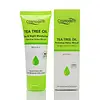What's inside
What's inside
 Key Ingredients
Key Ingredients

 Benefits
Benefits

 Concerns
Concerns

 Ingredients Side-by-side
Ingredients Side-by-side

Water
Skin ConditioningHamamelis Virginiana Water
AstringentAloe Barbadensis Leaf Juice
Skin ConditioningGlycerin
HumectantPolysorbate 20
EmulsifyingButylene Glycol
HumectantYeast Beta-Glucan
Skin ConditioningPropylene Glycol
HumectantChamomilla Recutita Flower Extract
MaskingFucus Vesiculosus Extract
EmollientHexylene Glycol
EmulsifyingCaprylyl Glycol
EmollientXanthan Gum
EmulsifyingAcrylates/C10-30 Alkyl Acrylate Crosspolymer
Emulsion StabilisingOpuntia Ficus-Indica Stem Extract
Skin ConditioningPhenoxyethanol
PreservativeSodium Hyaluronate
HumectantBrassica Oleracea Italica Extract
AstringentLecithin
EmollientArbutin
AntioxidantTocopheryl Acetate
AntioxidantLinolenic Acid
CleansingGlutathione
Linoleic Acid
CleansingAscorbyl Palmitate
AntioxidantVitex Agnus-Castus Extract
AstringentCaprylic/Capric Triglyceride
MaskingTocopherol
AntioxidantCyclodextrin
AbsorbentAscorbyl Tetraisopalmitate
AntioxidantAscorbyl Glucoside
AntioxidantSorbitan Caprylate
EmulsifyingPropanediol
SolventBenzoic Acid
MaskingTriethanolamine
BufferingTetrasodium EDTA
Water, Hamamelis Virginiana Water, Aloe Barbadensis Leaf Juice, Glycerin, Polysorbate 20, Butylene Glycol, Yeast Beta-Glucan, Propylene Glycol, Chamomilla Recutita Flower Extract, Fucus Vesiculosus Extract, Hexylene Glycol, Caprylyl Glycol, Xanthan Gum, Acrylates/C10-30 Alkyl Acrylate Crosspolymer, Opuntia Ficus-Indica Stem Extract, Phenoxyethanol, Sodium Hyaluronate, Brassica Oleracea Italica Extract, Lecithin, Arbutin, Tocopheryl Acetate, Linolenic Acid, Glutathione, Linoleic Acid, Ascorbyl Palmitate, Vitex Agnus-Castus Extract, Caprylic/Capric Triglyceride, Tocopherol, Cyclodextrin, Ascorbyl Tetraisopalmitate, Ascorbyl Glucoside, Sorbitan Caprylate, Propanediol, Benzoic Acid, Triethanolamine, Tetrasodium EDTA
Water
Skin ConditioningCyclomethicone
EmollientPropylene Glycol
HumectantHydrogenated Polyisobutene
EmollientTalc
AbrasiveTitanium Dioxide
Cosmetic ColorantEthylhexyl Methoxycinnamate
UV AbsorberAluminum Starch Octenylsuccinate
AbsorbentCetearyl Alcohol
EmollientGlyceryl Stearate
EmollientCetyl Alcohol
EmollientDimethicone
EmollientPolysorbate 20
EmulsifyingBenzophenone-3
UV AbsorberEthoxydiglycol
HumectantSulfur
AntiseborrhoeicCucumis Sativus Fruit Extract
EmollientMagnesium Aluminum Silicate
AbsorbentTocopherol
AntioxidantSorbitan Caprylate
EmulsifyingDipalmitoyl Hydroxyproline
Skin ConditioningDipotassium Glycyrrhizate
HumectantTriethanolamine
BufferingBisabolol
MaskingMelaleuca Alternifolia Leaf Oil
AntioxidantHyaluronic Acid
HumectantWater, Cyclomethicone, Propylene Glycol, Hydrogenated Polyisobutene, Talc, Titanium Dioxide, Ethylhexyl Methoxycinnamate, Aluminum Starch Octenylsuccinate, Cetearyl Alcohol, Glyceryl Stearate, Cetyl Alcohol, Dimethicone, Polysorbate 20, Benzophenone-3, Ethoxydiglycol, Sulfur, Cucumis Sativus Fruit Extract, Magnesium Aluminum Silicate, Tocopherol, Sorbitan Caprylate, Dipalmitoyl Hydroxyproline, Dipotassium Glycyrrhizate, Triethanolamine, Bisabolol, Melaleuca Alternifolia Leaf Oil, Hyaluronic Acid
Ingredients Explained
These ingredients are found in both products.
Ingredients higher up in an ingredient list are typically present in a larger amount.
Polysorbate 20 is made by combining ethoxylation of sorbitan, ethylene oxide, and lauric acid. It is a mild cleansing agent, surfactant, and emulsifier.
As a surfactant, it helps collect dirt and oils for washing. Emulsifiers prevent oils and water from separating.
Polysorbate 20 also adds scent to a product. Since it is made using sorbitol, it has a sweet scent. Sorbitol can also be found in fruits such as apples and peaches.
The lauric acid used to create Polysorbate 20 is often derived from coconuts.
Polysorbate 20 may not be fungal acne safe.
Learn more about Polysorbate 20Propylene Glycol is an odorless, colorless liquid. As a humectant, it helps skin retain moisture. It also aids in delivering active ingredients.
Another role of this ingredient is preventing a product from melting or freezing. Propylene glycol also adds antimicrobrial properties to a product, elongating product lifespan.
This ingredient is considered an organic alcohol and commonly added into both cosmetics and foods.
Those with sensitive skin or conditions may develop a rash when using this ingredient.
Learn more about Propylene GlycolWe don't have a description for Sorbitan Caprylate yet.
Tocopherol (also known as Vitamin E) is a common antioxidant used to help protect the skin from free-radicals and strengthen the skin barrier. It's also fat soluble - this means our skin is great at absorbing it.
Vitamin E also helps keep your natural skin lipids healthy. Your lipid skin barrier naturally consists of lipids, ceramides, and fatty acids. Vitamin E offers extra protection for your skin’s lipid barrier, keeping your skin healthy and nourished.
Another benefit is a bit of UV protection. Vitamin E helps reduce the damage caused by UVB rays. (It should not replace your sunscreen). Combining it with Vitamin C can decrease sunburned cells and hyperpigmentation after UV exposure.
You might have noticed Vitamin E + C often paired together. This is because it is great at stabilizing Vitamin C. Using the two together helps increase the effectiveness of both ingredients.
There are often claims that Vitamin E can reduce/prevent scarring, but these claims haven't been confirmed by scientific research.
Learn more about TocopherolTriethanolamine is an emulsifier and pH adjuster. It is created using ethylene oxide and ammonia. This gives Triethanolamine a nitrogen core and a similar scent to ammonia.
As an emulsifier, it prevents ingredients from separating and enhances texture by adding volume to a product.
PH adjusters are common in cosmetic products. The pH of a product can affect the effectiveness of other ingredients. A product with a high pH may also irritate the skin.
Learn more about TriethanolamineWater. It's the most common cosmetic ingredient of all. You'll usually see it at the top of ingredient lists, meaning that it makes up the largest part of the product.
So why is it so popular? Water most often acts as a solvent - this means that it helps dissolve other ingredients into the formulation.
You'll also recognize water as that liquid we all need to stay alive. If you see this, drink a glass of water. Stay hydrated!
Learn more about Water